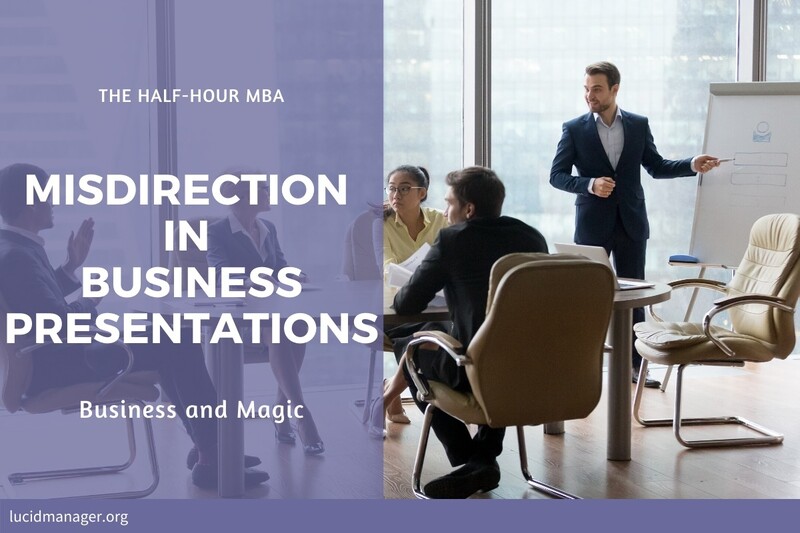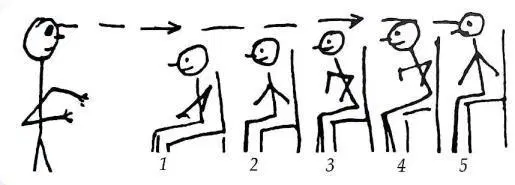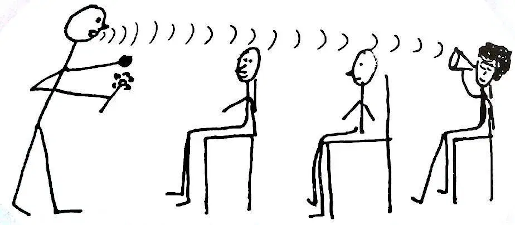
Misdirection in Presentations: Magic Shows in the Board Room

Peter Prevos |
1078 words | 6 minutes
Share this content
In a blog entry for Harvard Business Review, Jerry Weissman argued that misdirection is for magicians, not for presenters. Weissman writes that misdirection has no place in business presentations because a presenter needs to direct the attention of the audience to the screen, not distract them.
While distracting your audience is indeed not a good presentation technique, managers can learn from magicians to perform better presentations. Business people that perform magic have been found to be better public speakers than other presenters.1 This article shows how managers can use misdirection for presentations.
Misdirection in the Office
Misdirection is one of the few words of the specialist magician’s vocabulary that have made it into everyday speech.2
Misdirection is an essential technique in sleight of hand conjuring used to ensure that the audience cannot identify the causes of the actions of the magician. While the magician hides a ball in her left hand, she focuses the attention of the audience on her right hand so that the ball remains outside the field of awareness of the spectator. Some magicians no longer use the term misdirection but prefer ‘attention management’ to indicate that that the audience is directed towards the narrative of the magic trick instead of the technique.
Techniques to distract people from the real cause of things is not only used by magicians but in all forms of the performing arts. Some scholars even argue that misdirection is an essential skill in everyday human interaction.3
Erving Goffman described the interaction between humans as a theatrical metaphor and emphasised the importance of managing the impressions that people have of each other.
Goffman writes that we are all actors in a play of our own making; we have scripts, props and costumes to portray how we want the outside world to perceive us. We require misdirection in our daily and professional lives to construct who we are by our ideal self. One of the ways professionals communicate their corporate positions communicate is through clothing and managers are, according to Goffman:
… blinding themselves and others to the fact that they hold their jobs partly because they look like executives, not because they can work like executives.
Misdirection is as such a normal aspect of our lives and probably more so in the office. Working life is an artificial reality where people wear uncomfortable clothes to misdirect the attention away from their true self. Goffman’s ideas might seem a pessimistic interpretation of human interaction, but deception is part of life because social reality is subjective.
The manager has become an archetype of contemporary society. The manager is the prime example of homo economicus, the rational thinking problem solver that always seeks to maximise benefit, independent of social reality. This thought is, however, only an ideal that many of us strive to and we all play a role in the great theatre of life. Misdirection in Presentations
Business presentations are a form of theatre even more so. Brief monologues designed to convince the listener that the presenter’s ideas should be implemented. Misdirection is a valid and natural way to create the ideal self of the lucid manager and persuade people with your presentations. This post is, however, not an invitation to deceive in business presentations. Misdirection only works when it is subtle and skillfully applied.
Public speaking fills many people with fear. Jerry Seinfeld once joked that:
“… people’s number one fear is public speaking. Number two is death. This strong statement means to the average person that if you have to go to a funeral, you are better off in the casket than doing the eulogy”.
A good presenter needs to manage the attention of the audience away from the unimportant aspects of their presentation and focuses the listener on on the narrative.
In the Powerpoint era, beautifully designed slides can be used to give credence to an otherwise weak argument. The summarised and seemingly well-flowing information hides gaps in knowledge and insecurities of the presenter.
For professionals, public speaking is an essential skill which unfortunately not many of them excel at. We all have sat through death by Powerpoint; bombarded with slides and poorly presented disjointed information. What Managers can learn from Magicians
In my opinion, presentation skills are essential to succeed in any organisation—business presentations are a form of theatre. In this post, I will explain how a book favorite among magicians, The Five Points of Magic by Spanish performer Juan Tamariz—can be used to teach professionals about presentation skills.
Below are some tips from the book that apply to both magicians and public speaking.
The Eyes
Eye contact is the most vital tool to connect with the audience. Don’t only look at the first row. Sweep your gaze like a fan across the spectators, giving everybody some personal attention.

The Hands
The hands are the most critical tool of the magician, and in business presentations, they usually perceived get in the way. But the hands can communicate almost anything. We should use our hands to point out things, present objects and emphasise the communication. Think about how you use your hands other than a means to hold your laser pointer.
The Voice
Imagine an elderly lady, who is hard of hearing, sitting at the back of the room. Dedicate the performance to her and project your voice to the last row.

The Feet
The best place to stand is centre stage, facing the audience. Don’t hide behind the lectern or turn your back to the audience. This positioning is essential to be able to make good eye contact.
The Body
Body language is our subconscious means of communication. In theatre, and thus also in public speaking, we need to be aware of this type of communication.
In Conclusion
This post is only a glimpse into the vast array of literature on theatrical performances that can be applied to public speaking.
Next time you need to do a presentation, view it as a theatrical performance and follow the five points of public speaking.
One last tip: whatever you do, never imagine your audience naked, at best it will get you distracted.
Endnotes
Share this content


